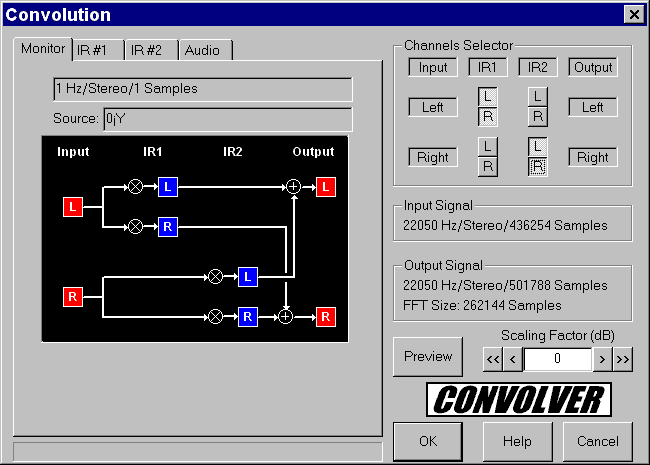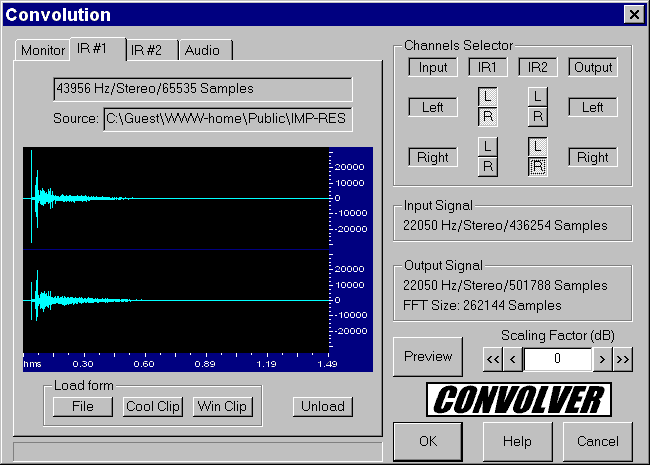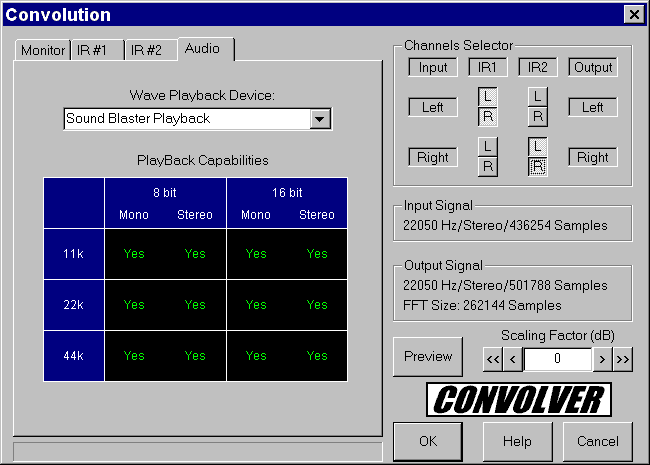Real Time Convolver
Convolution is the mathematical operation which is required to "filter" an anechoic signal with an impulse response, obtaining a reverberated signal. If the process is performed simultaneously with a binaural (stereo) impulse response, the result is a stereo waveform which is capable of giving true three-dimensional acoustic imaging when listened through suitable headphones.
It is also possible to produce a realistic loudspeaker reproduction, provided that the listening environment is hemi-anechoic and that a proper cross-talk cancellation is implemented into the impulse responses to be convolved.
This is the user's interface of the Real Time Convolver, actually available as a plug-in for Cool Edit 96 and Cool Edit Pro:
 |
 |
 |
Another older version of Aurora's Convolver exists, in the form of a transparent extension to the CoolEdit software.
Software Convolution Vs. Hardware Convolution
Although specialised hardware capable of real-time convolution already exists (look at Lake DSP for this), Aurora makes use of a software-only solution: this means that all the computations (mainly very large FFTs and IFFTs with single precision float arithmetic) are made inside the CPU. Until yesterday it was impossible to get real-time convolution on a standard PC, but now this is no more true! We are pleased to announce that this new module can outperform DSP-based real-time convolvers, on a reasonably fast PC. As in the past, anyway, the user is free also to prepare pre-convoluted samples in short times: these samples can be played later to listening groups for subjective evaluations.
This table shows the real-time performance limits on the PCFARINA PC (Pentium Pro 200 Mhz, 256 k cache), working with 44.1 kHz waveforms:
Description |
N. of channels of the |
N. of channels of the |
Impulse Response |
mono input with mono IR |
1 |
1 |
1,000,000 |
mono input with stereo IR |
1 |
2 |
512,000 |
stereo input with stereo IR |
2 |
2 |
300,000 |
stereo input with 2 stereo IRs |
2 |
4 |
14,000 |
This table shows the real-time performance limits on a Pentium MMX 200 Mhz, working with 44.1 kHz waveforms:
Description |
N. of channels of the |
N. of channels of the |
Impulse Response |
mono input with mono IR |
1 |
1 |
1,000,000 |
mono input with stereo IR |
1 |
2 |
64,000 |
stereo input with stereo IR |
2 |
2 |
16,000 |
stereo input with 2 stereo IRs |
2 |
4 |
4,000 |
Sound Samples
- 09-22k.wav - 856710 bytes - "Haendel" anechoic music sample (mono), 19.1 s - digitally transferred from the DENON audio-CD PG-6006 "Anechoic Orchestral Music Recording" by use of the Digital Domain program of Michiel Overtoom and a Toshiba E-IDE CD-ROM drive - resampled at 22kHz and de-noised with CoolEdit
- 09-folsp.wav - 1913230 bytes - the same sample convolved with binaural experimental impulse responses - now it is stereo! - the total processing time was 51.2 s on a Pentium-90 computer, including the time for initial FFT on the impulse responses and for reading and saving the data on the disk - the "pure CPU" time was less than 20s.
- foli-p12.wav - 262260 bytes - the MLS-deconvoluted binaural impulse responses (stereo file), measured in the Foligno's Cathedral with:
- a Sound Blaster 16-bit compatible board (ES688 AudioDrive, incorporated into a NEC Versa notebook)
- a SONY TCD-D3 DAT recorder
- a SONY DR-W70C Binaural Microphone
- a custom-made, low-cost dodechaedron loudpspeaker (it can be supplied on request to Aurora users)
- an MLS signal of 65535 points generated with the Aurora software, and played in a continous loop with CoolEdit.